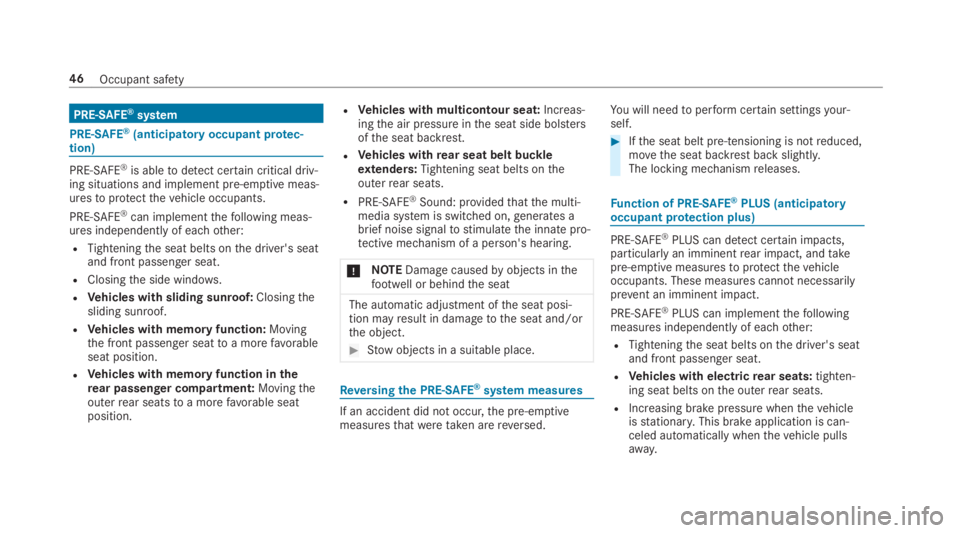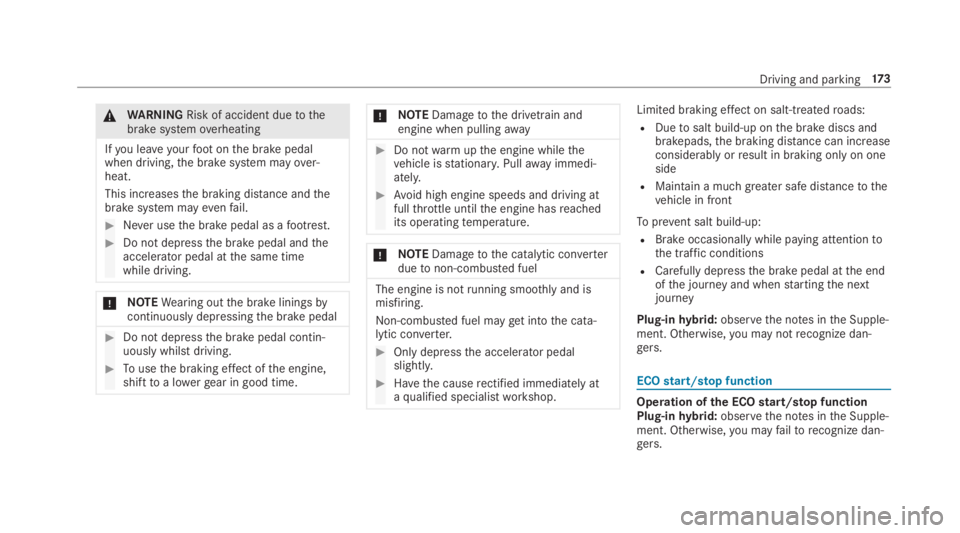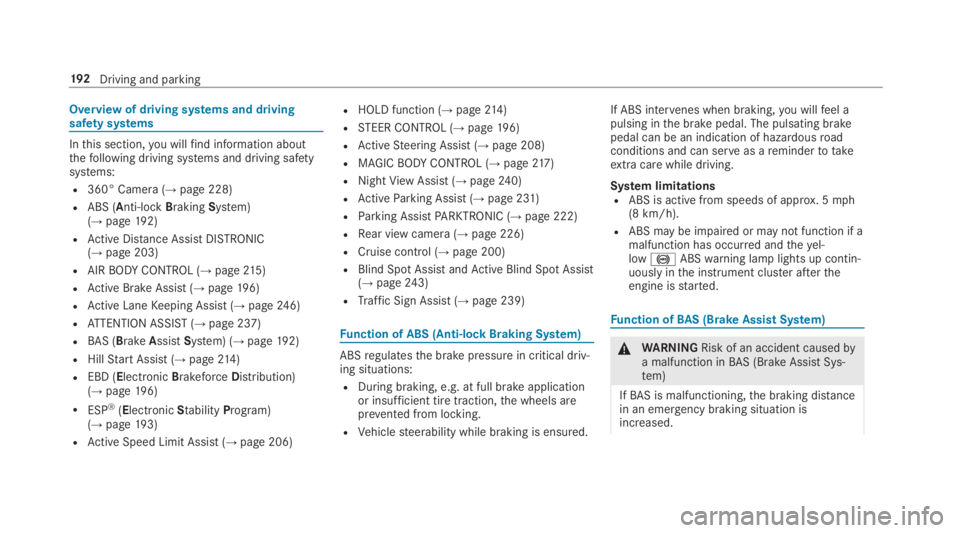2019 MERCEDES-BENZ S CLASS brake light
[x] Cancel search: brake lightPage 9 of 578

1Steering wheel paddle shifter→178
2Combination switch→14 6
3DIRECT SELECT lever→17 7
4PASSENGER AIRBAGindicator lamps→43
5Display (multimedia system)→278
6Start/stop button→16 8
7Climate control systems→15 9
8Glovebox→12 3
9Stowage compartment→12 2
ACup holder→131
BHazardwarning lights→147
CExtendstherear seat headrestraints→106
DParking AssistPARKTRONIC→225
EControl elementsforthe multimedia system→279
FActiveParking Assist→233
GSetsthevehicle level→216
HDYNAMIC SELECT switch→176
IECOstart/stop function→174
JControl panelforthe multimedia system→252
KAdjuststhesteering wheel→11 3
LControl panelfor:
On-board computer→252
Operates cruise control→201
OperatesActive Distance AssistDISTRONIC→204
MUnlocksthe hood→397
NElectric parking brake→188
OLight switch→14 5
PControl panelfor:
ActiveSteering Assist→210
Active LaneKeeping Assist→24 8
NightViewAssist→24 2
Head-up Display→262
Rear window roller sunblind→77
Ataglance – Cockpit7
Page 28 of 578

QR codeforrescue card
The QR code is secured inthe fuelfillerflap andonthe opposite side onthe B-pillar. Intheeventof an accident,rescue services can usethe QRcodetoquicklyfindthe appropriaterescue cardforyourvehicle. The currentrescue card con‐tainsthe most important information aboutyourvehicle in a compactform, e.g.therouting oftheelectric lines.
Further information can be obtained at http://www.mercedes-benz.de/qr-code.
Datastorage
Electronic control units
Electronic control units are installed inyourvehi‐cle. Some ofthese are necessaryforthe safeoperation ofyourvehicle, while some assistyouwhen driving (driver assistance systems). Inaddition,yourvehicle provides comfortandentertainment functions, which are also madepossiblebyelectronic control units.
Electronic control units contain datamemorieswhichcantemporarily or permanentlystore
technical information aboutthevehicle's operat‐ingstate, component loads, maintenancerequirements andtechnicalevents or malfunc‐tions.
Ingeneral,this information documentsthestateof a component part, a module, a system orthesurroundings such as:
Roperatingstatus of system components (e.g.fill levels, batterystatus, tire pressure)
Rstatus messages concerningthevehicle orits individual components (e.g. number ofwheelrevolutions/speed, longitudinal accel‐eration, lateral acceleration, display offas‐tened seat belts)
Rmalfunctions orfaults in important systemcomponents (e.g. lights, brakes)
Rinformation onevents leadingtovehicledamage
Rsystemreactions in special driving situations(e.g. airbag deployment, intervention ofsta‐bility control systems)
Rambient conditions (e.g.temperature,rainsensor)
In additiontoprovidingthe actual control unitfunction,this data assiststhe manufacturer indetecting andrectifying malfunctions and opti‐mizingvehicle functions. The majority ofthisdata istemporary and is only processed inthevehicle itself. Only a small portion ofthe data isstored intheevent or malfunction memory.
Whenyourvehicle is serviced,technical datafromthevehicle can beread outbyservice net‐workemployees (e.g.workshops, manufactur‐ers) orthird parties (e.g. breakdown services).Services includerepair services, maintenanceprocesses,warranty claims andquality assur‐ance measures,forexample. Theread out is per‐formed viathe legally prescribed portforthediagnostics connection inthevehicle. Therespective service network locations orthirdparties collect, process and usethe data. Theydocumenttechnicalstatuses ofthevehicle,assist infinding malfunctions and improvingquality and are transmittedtothe manufacturer,if necessary.Furthermore,the manufacturer issubjecttoproduct liability.Forthis,the manu‐facturerrequirestechnical datafromvehicles.
26General notes
Page 48 of 578

PRE-SAFE®system
PRE-SAFE®(anticipatoryoccupant protec‐tion)
PRE-SAFE®is abletodetect certain critical driv‐ing situations and implement pre-emptive meas‐urestoprotectthevehicle occupants.
PRE-SAFE®can implementthefollowing meas‐ures independently of eachother:
RTighteningthe seat belts onthe driver's seatand front passenger seat.
RClosingthe side windows.
RVehicles with sliding sunroof:Closingthesliding sunroof.
RVehicles with memory function:Movingthe front passenger seattoa morefavorableseat position.
RVehicles with memory function intherear passenger compartment:Movingtheouterrear seatstoa morefavorable seatposition.
RVehicles with multicontour seat:Increas‐ingthe air pressure inthe seat side bolstersofthe seat backrest.
RVehicles withrear seat belt buckleextenders:Tightening seat belts ontheouterrear seats.
RPRE-SAFE®Sound: providedthatthe multi‐media system is switched on,generates abrief noise signaltostimulatethe innate pro‐tective mechanism of a person's hearing.
*NOTEDamagecausedbyobjects inthefootwell or behindthe seat
The automatic adjustment ofthe seat posi‐tion mayresult in damagetothe seat and/orthe object.
#Stowobjects in a suitable place.
Reversingthe PRE-SAFE®system measures
If an accident did not occur,the pre-emptivemeasuresthatweretaken arereversed.
You will needtoperformcertain settingsyour‐self.
#Ifthe seat belt pre-tensioning is notreduced,movethe seat backrest back slightly.The locking mechanismreleases.
Function of PRE-SAFE®PLUS (anticipatoryoccupant protection plus)
PRE-SAFE®PLUS can detect certain impacts,particularlyan imminentrear impact, andtakepre-emptive measurestoprotectthevehicleoccupants. These measures cannot necessarilyprevent an imminent impact.
PRE-SAFE®PLUS can implementthefollowingmeasures independently of eachother:
RTighteningthe seat belts onthe driver's seatand front passenger seat.
RVehicles with electricrear seats:tighten‐ing seat belts onthe outerrear seats.
RIncreasing brake pressure whenthevehicleisstationary.This brake application is can‐celed automatically whenthevehicle pullsaway.
46Occupant safety
Page 170 of 578

iftheycome into contact withhot parts ofthe engine orexhaust system.
#Therefore,checkregularlythatthereare noflammable materials intheengine compartment or ontheexhaustsystem.
Requirements:RThe SmartKeyis located inthevehicle andthe SmartKeybattery is not discharged.
#Toswitch onthe power supply:press but‐ton1once.You can activatethe windshield wipers,forexample.
The power supplyis switched off again ifthefol‐lowing conditions are met:
Ryou openthe driver's door
Ryou press button1twice.
#Toswitch onthe ignition:press button1twice.The indicator lamps inthe instrument clusterlight up.
The ignition is switched off again if one ofthefollowing conditions is met:
Ryou do notstartthevehicle within15minutes.
The transmission is in position�].
or
The electric parking brake is applied.
Ryou press button1once.
Starting thevehicle
Starting thevehicle withthestart/stop but‐ton
Requirements:RThe SmartKeyis located inthevehicle andthe SmartKeybattery is not discharged.
#Shiftthe transmissiontoposition�]or�\\.
16 8Driving and parking
Page 175 of 578

&WARNINGRisk of accident duetothebrake systemoverheating
Ifyou leaveyourfootonthe brake pedalwhen driving,the brake system mayover‐heat.
This increasesthe braking distance andthebrake system mayevenfail.
#Never usethe brake pedal as afootrest.
#Do not depressthe brake pedal andtheaccelerator pedal atthe same timewhile driving.
*NOTEWearing outthe brake liningsbycontinuously depressingthe brake pedal
#Do not depressthe brake pedal contin‐uously whilst driving.
#Tousethe braking effect ofthe engine,shifttoa lowergear in good time.
*NOTEDamagetothe drivetrain andengine when pullingaway
#Do notwarmupthe engine whilethevehicle isstationary.Pullawayimmedi‐ately.
#Avoid high engine speeds and driving atfullthrottle untilthe engine hasreachedits operatingtemperature.
*NOTEDamagetothe catalytic converterduetonon-combusted fuel
The engine is notrunning smoothly and ismisfiring.
Non-combusted fuel mayget intothe cata‐lytic converter.
#Only depressthe accelerator pedalslightly.
#Havethe causerectified immediately ataqualified specialistworkshop.
Limited braking effect on salt-treatedroads:
RDuetosalt build-up onthe brake discs andbrakepads,the braking distance can increaseconsiderably orresult in braking only on oneside
RMaintain a much greater safe distancetothevehicle in front
Toprevent salt build-up:
RBrake occasionally while paying attentiontothe traffic conditions
RCarefully depressthe brake pedal atthe endofthe journey and whenstartingthe nextjourney
Plug-inhybrid:observethe notes inthe Supple‐ment. Otherwise,you may notrecognize dan‐gers.
ECOstart/stop function
Operation of the ECOstart/stop functionPlug-inhybrid:observethe notes inthe Supple‐ment. Otherwise,you mayfailtorecognize dan‐gers.
Driving and parking17 3
Page 194 of 578

Overview of driving systems and drivingsafety systems
Inthis section,you willfind information aboutthefollowing driving systems and driving safetysystems:
R360° Camera (→page 228)
RABS (Anti-lockBrakingSystem)(→page192)
RActive Distance AssistDISTRONIC(→page203)
RAIRBODYCONTROL (→page215)
RActive Brake Assist (→page196)
RActive LaneKeeping Assist (→page246)
RATTENTION ASSIST (→page 237)
RBAS (BrakeAssistSystem) (→page192)
RHillStart Assist (→page214)
REBD (ElectronicBrakeforceDistribution)(→page196)
RESP®(ElectronicStabilityProgram)(→page193)
RActive Speed Limit Assist (→page 206)
RHOLD function (→page214)
RSTEER CONTROL (→page196)
RActiveSteering Assist (→page 208)
RMAGICBODYCONTROL (→page217)
RNightViewAssist (→page240)
RActiveParking Assist (→page 231)
RParking AssistPARKTRONIC (→page 222)
RRear view camera (→page 226)
RCruise control (→page 200)
RBlind Spot Assist andActive Blind Spot Assist(→page243)
RTraffic Sign Assist (→page 239)
Function of ABS (Anti-lock Braking System)
ABSregulatesthe brake pressure in critical driv‐ing situations:
RDuring braking, e.g. at full brake applicationor insufficient tire traction,the wheels areprevented from locking.
RVehiclesteerability while braking is ensured.
If ABS intervenes when braking,you willfeel apulsing inthe brake pedal. The pulsating brakepedal can be an indication of hazardousroadconditions and can serveas aremindertotakeextra care while driving.
System limitationsRABS is active from speeds of approx. 5mph(8 km/h).
RABS may be impaired or may not function if amalfunction has occurred andtheyel‐low�%ABSwarning lamp lights up contin‐uously inthe instrument cluster aftertheengine isstarted.
Function ofBAS (Brake Assist System)
&WARNINGRisk of an accident causedbya malfunction inBAS (Brake AssistSys‐tem)
IfBAS is malfunctioning,the braking distancein an emergency braking situation isincreased.
19 2Driving and parking
Page 198 of 578

125mph (200 km/h) when drivingstraightahead or cornering slightly.
RThevehicle isstabilizedbymeans of individ‐ual brake application on one side.
Function of EBD (electronic brakeforce dis‐tribution)
EBD ischaracterizedbythefollowing:
RMonitoring andregulatingthe brake pressureontherear wheels.
RImproved drivingstability when braking,especially on bends.
Function ofSTEER CONTROL
STEER CONTROL helpsyoubytransmitting anoticeablesteeringforcetothesteering wheel inthe directionrequiredforvehiclestabilization.
Thissteeringrecommendation is given particu‐larlyinthefollowing situations:
RBothright wheels or bothleft wheels are onawet or slipperyroad surface whenyoubrake
RThevehiclestartstoskid
System limitations
STEER CONTROL may be impaired or may notfunction inthefollowing situations:
RESP®is deactivated
RESP®is malfunctioning
RThesteering is malfunctioning
If ESP®is malfunctioning,you will be assistedfurtherbythe electric powersteering.
Function ofActive Brake Assist
Active Brake Assistconsists of:
RDistancewarning function
RAutonomous braking function
RSituation-dependent braking assistance
RVehicles with Driving AssistancePack‐age:EvasiveSteering Assist
Active Brake Assistcan helpyoutominimizetherisk of a collision withvehicles or pedestrians ortoreducethe effects of sucha collision.
IfActive Brake Assisthas detected arisk of colli‐sion, awarningtone sounds andthe�
Page 201 of 578

Canceling a brake application ofActive BrakeAssist
You can cancel a brake application ofActiveBrake Assistat any timeby:
RDepressingthe accelerator pedal fully.
RReleasingthe brake pedal.
Active Brake Assistmay cancelthe brake appli‐cation when one ofthefollowing conditions isfulfilled:
RYou maneuverto avoidthe obstacle.
RThereis no longer arisk of collision.
RAn obstacle is no longer detected in front ofyourvehicle.
EvasiveSteering Assist (onlyvehicles withDriving AssistancePackage)
EvasiveSteering Assist hasthefollowingcharac‐teristics:
RCan detectstationary or crossing pedes‐trians.
RCan assistthe driver with additionalsteeringassistance if it detects a swerving maneuver.
RCan be activatedbyan abruptsteering move‐ment during a swerving maneuver.
RCan assist during swerving andstraighteningofthevehicle.
RCanreact from a speed of approximately12mph (20 km/h) uptoa speed of approx‐imately 43mph (70 km/h).
RYou can preventthe assistance at any timebyactivelysteering.
&WARNINGRisk of an accident despiteEvasiveSteering Assist
EvasiveSteering Assist cannotalways clearlyidentify objects and complex traffic situa‐tions.
In addition,thesteering support of EvasiveSteering Assist isgenerally not sufficienttoavoid a collision.
In such cases EvasiveSteering Assist can:
Rgive an unnecessarywarning or provideassistance
Rnot giveawarning or not provide assis‐tance
#Always pay careful attentiontothe traf‐fic situation; do notrely on EvasiveSteering Assist alone.
#Bereadytobrake andtakeevasiveaction if necessary.
#Preventthe assistancebyactivelysteer‐ing in non-critical driving situations.
#Drive at an appropriate speed if pedes‐trians are closetothe path ofyourvehi‐cle.
Also observethe system limitations of EvasiveSteering Assist.
System limitations
The system may be impaired or may not functioninthefollowing situations:
RIn snow,rain,fog, heavy spray, ifthere isglare, in direct sunlight or ingreatlyvaryingambient light.
RIfthe sensors are dirty,fogged up, damagedor covered.
Driving and parking19 9